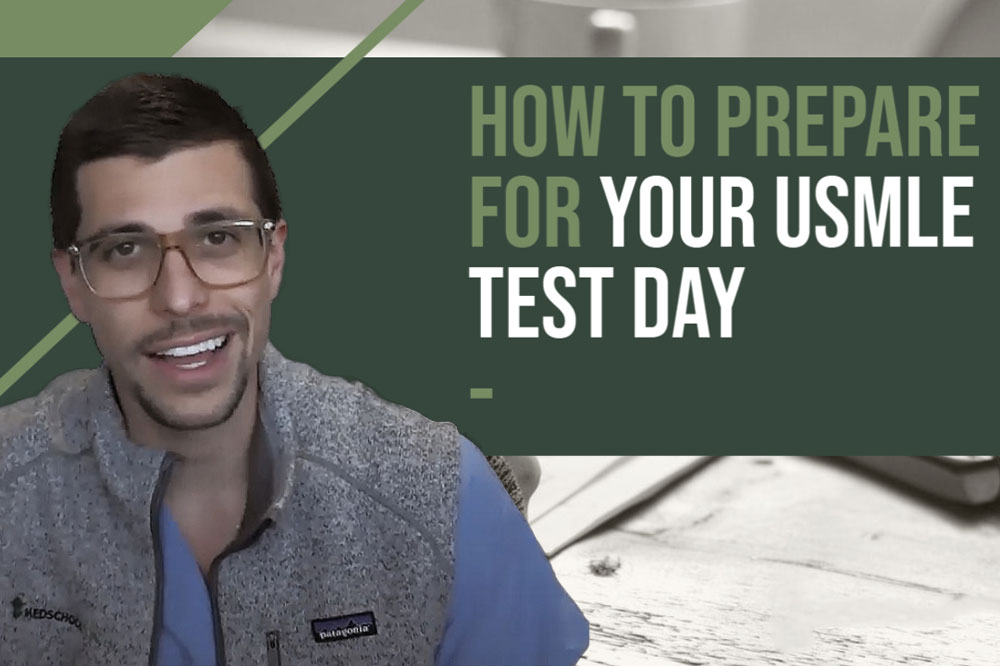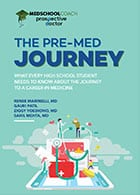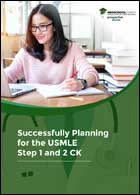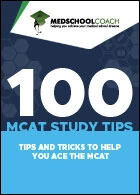
Dr. Joel Ramirez from MedSchoolCoach details what future physicians can expect on USMLE exam Test Day, and provides tips for how they can prepare and succeed with the very same USMLE Step 1 preparation schedule he used.
- What studying should you do the day before the exam?
- What key rules does the exam center have that you should know?
- What notes should I take during the exam?
- When is the ideal time to take breaks during the exam?
- What tips will help me ace the USMLE on Test Day?
Watch the video below and find out!
Full Transcript:
Hello everyone, this is Joel Ramirez, Director of Medical School Tutoring at MedSchoolCoach. Today, we’re going to be talking about things that you can do right before your exam to maximize your exam day.
So, first of all, congratulations, you’ve worked so hard and you’re almost to your exam day. It’s hopefully just round the corner. We are confident that you’re going to be prepared for exam entering, and are going to do a great job. So let’s talk about some last minute things you can do.
The things that I often get asked about is: What should I do the day before my exam? Should I review notes? Should I do note cards? Should I do a bunch of questions? My answer is always just relax.
So you really want to start the day before your exam relaxing, getting some sleep, getting some rest, and really preparing for your test date. So do something fun. Go exercise. Hang out with your friends or family, but take that day, the day of rest, and prepare it in preparation for your exam day, which will likely be a pretty challenging and long day.
So let’s talk about the actual exam day. How can you help yourself set yourself up for the success on your exam day?
The first and the most simplest thing is: know where you’re going to be taking your exam. So make sure you know where your testing centers are and how you’re going to get there.
And the other thing is: make sure you leave a little early to get there. The last thing you want to be doing is rushing to your exam day and show up all panicked and stressed out. So Google Maps, see how long it takes to get to your testing site and then make sure you make a little bit of time to leave a little early so that you’re ahead of schedule instead of running late. Some things can happen in the morning to throw your schedule off and you really want to give yourself a little bit of extra buffer to get to your testing center.
We’re going to talk about what to expect when you get to your testing center. So right now, the NBME is experimenting with different forms of testing centers. And what we talk about might not be exactly reflective of what your experience will be, but I will talk about what things will actually be like if you go to a Prometric testing center.
First of all, it’s really important to read the instructions that they email to you ahead hard time. In those instructions they’ll talk about several things you need to bring your test day.
They’ll talk about a lot of their rules and regulations.
And they’ll also send you a testing permit. Make sure you protect your testing permit and bring it to your test day. You’ll also want to make sure you have a form of valid I.D. The Prometric testing sites will sometimes accept a digital testing permit, but print it out just in case. If you lose it, then you should be able to pull it up your phone, which should be acceptable, but I think it’s reasonable to print it out and have it with you just so you can be prepared.
The first you’re going to do when you get there is going to check in. You go to the front desk and you are going to provide them with your testing permit and your ID. You’ll be there with several other people taking exams and they’re not all taking USMLE exams. Some will be taking the MCAT or the GRE or the GMAT or other certifying exams. You’ll be with a fairly heterogeneous group of people.
When you get to the test date, once you check in and show your ID, the next thing they’ll do is they’ll give you a locker key. And they essentially provide you with a small locker to put your belongings in. You have to put all your belonging in there like you wallets, watch, jewelry, and then your phone. And make sure your phone is turned off and on silent. I always recommend to my students to just turn off and keep it off throughout the exam that way you’re not anxiously checking your phone on what answers you might have gotten right or might have gotten wrong in between your blocks. I think it’s just a good idea just to turn off, not let it distract you during the day, even on breaks. It’s very reasonable just do that. You also can put your snacks in your locker.
The next is what they actually provide you with it. They will provide you with some actual plug-in headphones for your computer – just like those earmuff headphones you plug-in to the computer. And you want to make sure that those are working before you take your test exam. And they actually do all the prompts on the screen and walk you through essentially how to test your headphones. And the headphones are usually used for small videos like murmurs or other exam maneuvers. You don’t need them too often, but it is very possible that you might need them during your exam.
The other thing that they give you is they give you like these noise cancelling earmuffs. They’re very old, rubber and uncomfortable earmuffs that are supposed to block out sound, but they don’t work very well. So for people who get distracted by noise, I always recommend that they actually bring their own earplugs. And so you can bring your own set of earplugs to the exam. Make sure you read Prometrics rules on the plugs as they only allow certain forms of earplugs. I believe that they only allow that the foam earplugs, not the wax earplugs. So read up on that and make sure you are using the same headphones that they will allow you to do. You can bring your own headphones. It ends up working a lot better than using their old rubber earmuffs, essentially.
They’ll also give you two pages of essentially laminated scrap paper and a marker. And so you need this to write notes throughout your exam or write down your thoughts.
Some students ask me: there is a certain pathway that I find challenging to memorize. When I just start the exam, should I scribble the whole thing down there just so it’s on there. My general recommendation is not to do this. I think it’s generally a waste of time and space. You might not even see a question on that certain topic. And so I just think it’s not really worth it. If you run across a question which is a challenging pathway that’s easier for you write out, by all means, draw the whole things out at that time. But I generally find that the laminate piece of paper are really most useful for equations and math, things like statistics and things like that. Do your four by fours and write out your statistics questions. I find that to be the best use of the laminate paper and that’s typically what I recommend that people do.
Before you actually actually enter your before you actually enter the exam room, which is where desk and all your materials will be, you have to essentially undergo a pat down. So you’ll get your fingers scanned, you’ll sign in and then they’ll tell you to pull out all your pockets in your shirts and your jackets and they’ll look in all your pockets. If you’re wearing glasses they’ll have you take off your glasses and they’ll inspect them. They’ll have you do twirl and then they’ll do a metal detector. So it’s usually kind of an uncomfortable process, but doesn’t take too long and just be expecting it before you get started.
The second is once you get going, you can take breaks whenever you want. If you take a break in between a block, it’s considered an “authorized break” break and you just hit the button on a computer, follow a prompt and go take a break. If you take it in the middle of a block it’s considered an unauthorized break. And similarly, you just click the button and leave.
There are variable start times. So I know you signed up for exams start at 8AM, but usually these testing centers will begin letting students in 30 minutes before the actual exams start times. It’s essentially a first come, first serve. So if you show up late, you will be starting your test late. If your exam is good for 8 and people start coming in at 7:30 and you show up at 8, then it’s likely that you want actually start your exam until 8:30 or 8:45. So another reason to show up early, get to the front of the line, get started, get through your exam and move on through your day.
Make sure you come prepared with your snacks. So, people all have a lot of questions about how to schedule their test day. So in the sense of you got your exam, but how do you partition your blocks? What kind of food do you eat? How do you really set those for your success? And I think the answer to this is very variable. It’s really going to depend on you. There are a few recommendations that I do give to people though. I think it’s most useful to bring a lot of snacks. Even if you bring a substantial meal, make sure you have a lot of snacks because it’s a long, really exhausting day and want to make sure that if you are on break and you’re really hungry, that you have some food with you that you can eat. Bring some water. And if you’re a coffee drinker, bring some coffee. The details of when you snack becomes very different depending on the person you are. So for me, I knew that if I had like large meals and I get like a really bad food coma. So I didn’t eat a large lunch or anything like that. I just had snacks the whole day. I’m also a big coffee drinker and in the afternoon I’ll get really sleepy if I don’t drink coffee. So I brought my coffee with me and after my fourth block I drank my coffee. So think about what your kind of dietary habits are and then plan your schedule based around that.
And the best way to do this is to practice. So take several blocks of UWorld, write out a plan for your snacks and your coffee or whatever, and then try it and see how it goes. And if it works well for you, then keep doing it. If it doesn’t work well, then you’ll have a chance to adjust because you really want to make sure that you’re not really hungry or dehydrated during this day, because it’s a pretty long day.
That gets to the next question that we get about How do I schedule my test day is: When should you take your breaks? And it’s similar to our meals. It is going to be very variable, depending on the person. And so I will tell you what I typically recommend students do, and then it’s going to be really important that you try it out and you see what works for you.
What I find is that I think it makes sense to do the blocks of two at a time or take a break every other block. The reason is: you have to check in and check out. Every time you take a break, you have to check out of the testing center, which means you have to get your fingerprints, sign out, then you go do your thing. But every time you come back, you have to use your fingerprint, sign back in, and leave to go through the whole security check. So they’ll have you pull out your pockets. They’ll have you do a twirl. They’ll look at your glasses and they’ll do a metal detector scan. And so this process could take anywhere three to five minutes and it could take even longer if there’s a line. So if multiple people are taking breaks at the same time, and you’re in this line, it could take five to 10 minutes. And although that doesn’t sound like a lot of time, if you have a ten to fifteen minute break, that ends up really cutting into your break. It can be a little stressful. So I can tell you what I did, and I can tell you what I recommend most students do.
What I did is I decided to go two blocks, take a break, two blocks, take a break. And go block, break, block, break. And the reason I did this is I felt that I was freshest at the beginning of the day. And so it was really easy for me to focus on doing two blocks, take a quick break, run the restroom, grab some water, grab a quick snack, and then get back at it and try to take two more blocks. And then after that fourth block, I took a longer break that was like 20 or 30 minutes. I had some more food. I had some water and had my coffee. And for me, that was like a very psychologically useful kind of strategy, because by the time I finished my fourth block, I knew that I was mostly done with the exam. I had it done 4 blocks and I only had 3 blocks left. And so for me, it was really psychologically much easier to do it that way. And then I would do a block, take a quick break, do a block, take a quick break, do a block. And I was done.
And that worked really well for me. And it minimize the amount of time that you’re having to check in and check out from breaks. Because if you’re someone who has to pee often, or you know you’re going to be wanting water every hour or wanting some snacks every hour, then it’s reasonable to take a break after every block. But make sure you’re taking quick breaks because the time can to add up, and it can take a little bit of time to get back into the exam room. You don’t want to be rushed to get back into your exam room or run out of break time. And again, if you’re finding this overwhelming, the best piece of advice is practice this. So again, practice, simulate your test day, take several blocks of UWorld, write down some scheduled breaks and some scheduled snacks that you think is going to work for you. And try it and see how it works. And if it works, then you can use that for test day, and if it doesn’t work you can adjust from there.
So moving on to how to act when you actually take your test. Some tips that you can use to make yourself a better test taker. The first thing is relax, relax, relax. When you get there, you’ll be really anxious. It’s a big day, you’ve been preparing for it for a while. It’s going to be a very unnatural environment. It’s going to be kind of a little cold. And you’re not used to the computers, and you’re not used to being patted down before you take your exams. So first thing you want to do is take a moment, relax, take some deep breaths and focus on the exam.
I think it’s really useful to employ practice meditations, square breathing or other relaxation techniques. You can Google a few and you can try them out. And I think particularly at the beginning of the day when you’re really anxious before you’ve gotten started, it’s really useful to practice those. So before you take your test, close your eyes, take a few deep breaths, and then get ready for the exam.
And during the exam, there’s a few things that you want to really practice doing. Stay focused and stay positive. Staying focused is really challenging towards the end of the day. It’s a long game day, and there’s a lot of questions. And so it’s really important that you train yourself to focus on each question as if it’s the most important question you’re going to do during the day. It’s really easy to start clicking through or start getting burnt out on questions. But you really want to approach each question as if this is the most important question of the day.
And the other is: stay positive. These exams are really challenging to be really disheartening even when you’re taking the exam. You’re going to see questions that you’ve never in your life seen before. You’re going to see questions that you have no clue what the answer is. But it’s really important that you stay positive. You do not need to get 100 percent to score well on this exam. So even on those really challenging questions which you’re completely stumped by, choose your best answer and move on to the next question. It’s really important that you keep that positive attitude because you want to avoid getting yourself stuck in a rut or going down this downward negative spiral or feeling like you know nothing. Again, you don’t need to get 100 percent of questions right to do well on this exam.
The next thing is, every time you approach a block, it is a new block. So the end of every block or before starting each block, close your eyes, take a few deep breaths and focus on the next block. You can have a really horrific block and then have an amazing block. The two are going to balance each other out. So even if you just felt you got demolished in the last block, really forget about it. It’s done. It’s over with. Put it in the back of your mind. Take a deep breath, and focus on the next block. You want to make each question and each block the absolute best that you can do. So even if you don’t feel like the exam is going your way, you really want to start each by block and each question with a fresh perspective and you’re gonna give it the best that you can.
And all these are very important for you to to have a really successful test day. And just like I keep hammering on, the easiest way to do this is to practice doing it. So when you’re doing your UWorld questions, when you’re doing your UWorld blocks, practice these techniques. Focus on each question as if it’s the most important question. And when you’re doing multiple blocks in a row, forget about the last block and focus on the next block.
So once you’ve taken your exam, what do you do next? Your scores will come out in about four to six weeks. So between test day and four to six weeks, you really will have absolutely no clue on how you did. Everyone leaves the test feeling horrible. Even if you did really well, and end up scoring really well, you’re probably going to feel like you just got hit by a truck. These are very tough exams. They’re very long days. Don’t dwell too much on how you felt on the actual test day and instead move on with your life. Move on to your third year clerkships or your sub internships or whatever else you have going on in your life. Try not to dwell too much on the exam and then you’ll get your score in four to six weeks and you can go from there.
We’re confident you’re going to do great. Good luck and take care!






